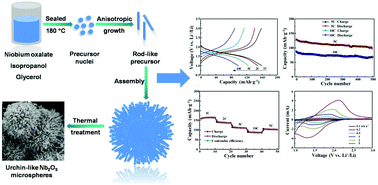Urchin-like hierarchical H-Nb2O5 microspheres: synthesis, formation mechanism and their applications in lithium ion batteries†
Abstract
Urchin-like hierarchical Nb2O5 microspheres are successfully synthesized through a facile solvothermal method in glycerol–isopropanol mixed media followed by thermal treatment. The sample is characterized by XRD, FESEM, TEM, HRTEM, BET, and XPS, and the results reveal that the as-formed Nb2O5 microspheres have a pseudohexagonal structure and are composed of nanorods with an average diameter of ca. 20 nm. It is found that glycerol not only serves as a solvent but also acts as a reactant; furthermore, isopropanol plays an important part in the morphologies of the products. When used as anodic materials for lithium ion batteries, the Nb2O5 microspheres deliver initial discharge capacities of 201.7, 159.7, 148.5, 123.7, and 98.5 mA h g−1 at the current densities of 0.5, 1, 2, 5, and 10C, respectively. Additionally, the discharge capacity of Nb2O5 remains at 105.5 mA h g−1 even after 500 cycles at a high rate of 5C. The good electrochemical properties of the products may be ascribed to their large surface areas and hierarchical structures.



 Please wait while we load your content...
Please wait while we load your content...